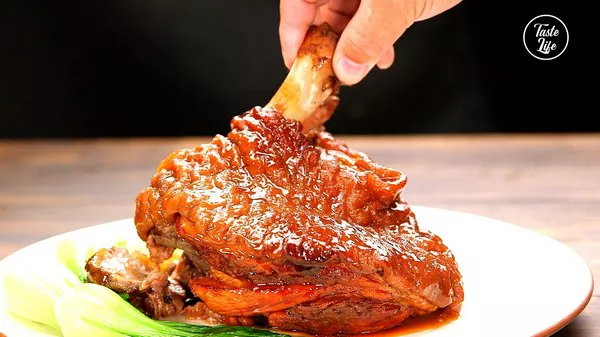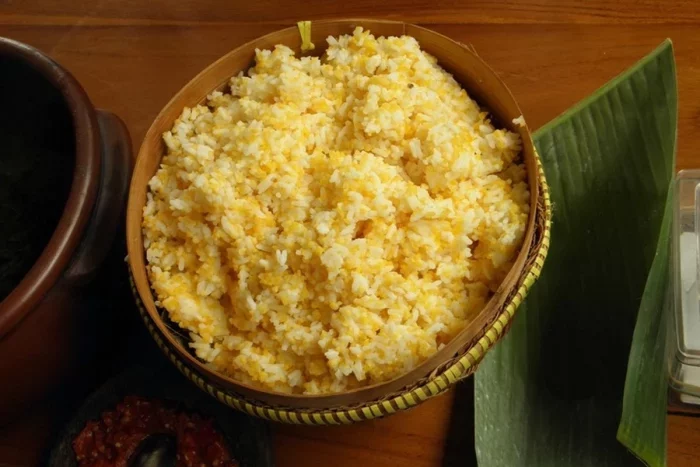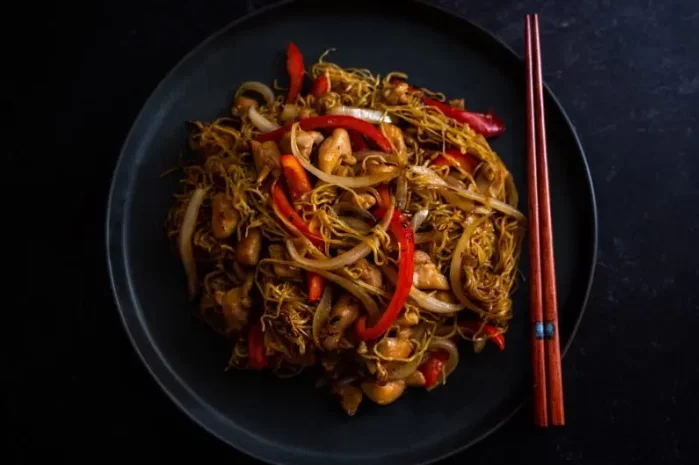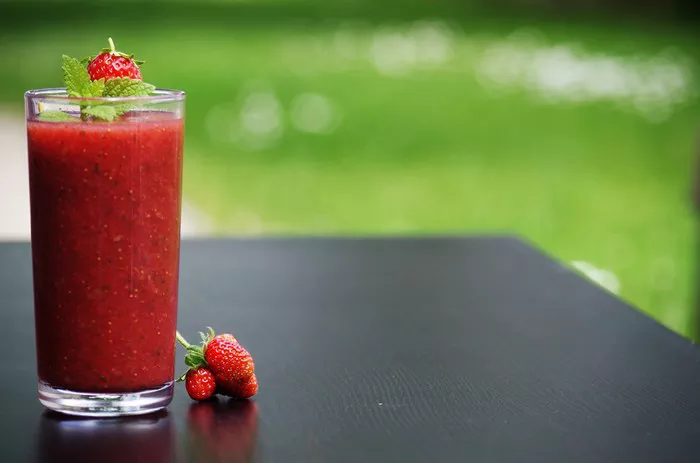Chinese cuisine is renowned for its depth of flavor, intricate preparation techniques, and the cultural significance of its dishes. Among the many beloved delicacies, the Chinese-style pork knuckle stands out as a dish that is not only sumptuous but also steeped in tradition. This article will guide you through the process of preparing this exquisite dish, ensuring that each step is executed with precision and care.
Ingredients and Preparation: The Foundation of Flavor
Before diving into the cooking process, it’s essential to gather all the necessary ingredients. Quality ingredients form the backbone of any great dish, and Chinese-style pork knuckle is no exception. Here’s a comprehensive list of what you’ll need:
Ingredients:
- Pork Knuckle (also known as Pork Hock): 1 large, cleaned and patted dry
- Soy Sauce: 1 cup, preferably dark soy sauce for a richer color and flavor
- Shaoxing Wine: 1/2 cup, this Chinese cooking wine adds depth and complexity
- Brown Sugar: 1/4 cup, to balance the savory elements with a touch of sweetness
- Garlic: 6 cloves, crushed
- Ginger: 1 piece (about 2 inches), sliced
- Star Anise: 2 whole
- Cinnamon Stick: 1
- Bay Leaves: 2
- Scallions: 4, tied into knots
- Chinese Five-Spice Powder: 1 teaspoon
- Chicken Stock: 4 cups, or enough to cover the pork knuckle
- Salt and Pepper: to taste
- Vegetable Oil: 2 tablespoons, for searing
- Optional Garnishes: Chopped scallions, cilantro, or toasted sesame seeds
Preparation:
- Cleaning the Pork Knuckle: Rinse the pork knuckle under cold running water to remove any bone fragments or impurities. Pat it dry with paper towels.
- Marinating: In a large bowl, combine the soy sauce, Shaoxing wine, brown sugar, garlic, ginger, star anise, cinnamon stick, bay leaves, scallions, and Chinese five-spice powder. Add the pork knuckle, ensuring it is well-coated with the marinade. Cover and refrigerate for at least 4 hours, preferably overnight, to allow the flavors to penetrate the meat.
Searing and Braising: Building the Layers of Flavor
The cooking process for Chinese-style pork knuckle involves searing and braising, which work together to create a dish with a rich, deep flavor and a tender, succulent texture.
Searing:
- Heating the Pan: In a large, heavy-bottomed pot or Dutch oven, heat the vegetable oil over medium-high heat until shimmering.
- Searing the Pork Knuckle: Remove the pork knuckle from the marinade, reserving the marinade for later use. Carefully place the pork knuckle in the hot oil and sear on all sides until golden brown. This step helps to develop a rich, caramelized crust that will enhance the overall flavor of the dish.
Braising:
- Adding Aromatics: Once the pork knuckle is seared, add the reserved marinade to the pot, along with any remaining garlic, ginger, star anise, cinnamon stick, bay leaves, and scallions.
- Deglazing: Pour in the chicken stock, scraping up any browned bits from the bottom of the pot. These bits, known as fond, are packed with flavor and will contribute to the depth of the braising liquid.
- Braising: Bring the mixture to a boil, then reduce the heat to low. Cover the pot and let the pork knuckle simmer gently for 2-3 hours, or until the meat is tender and easily pulls away from the bone.
- Adjusting Seasoning: Taste the braising liquid periodically and adjust the seasoning with salt and pepper as needed. The liquid should be flavorful and well-balanced, with a harmonious blend of savory, sweet, and aromatic notes.
Finishing Touches: Elevating the Dish
After the pork knuckle has braised to perfection, it’s time to focus on the finishing touches that will elevate the dish from delicious to extraordinary.
Reducing the Sauce:
- Removing the Pork Knuckle: Carefully transfer the pork knuckle to a large serving platter, covering it with foil to keep it warm.
- Reducing the Braising Liquid: Increase the heat under the pot to medium-high and bring the braising liquid to a boil. Allow it to simmer and reduce until it reaches a thick, glaze-like consistency. This process can take anywhere from 15 to 30 minutes, depending on the initial volume of the liquid.
- Straining the Sauce: For a smooth, elegant presentation, strain the reduced sauce through a fine-mesh sieve to remove the solids. This step ensures that the sauce has a velvety texture and a concentrated flavor.
Plating and Garnishing:
- Glazing the Pork Knuckle: Brush the reduced sauce over the pork knuckle, ensuring it is evenly coated and glistening with the rich, flavorful glaze.
- Garnishing: Sprinkle the pork knuckle with chopped scallions, cilantro, or toasted sesame seeds, adding a burst of color and freshness to the dish.
SEE ALSO: How to Make Char Siu Chicken
Serving Suggestions: Accompaniments and Pairings
Chinese-style pork knuckle is a versatile dish that can be served in various ways, depending on the occasion and personal preference. Here are a few serving suggestions to consider:
Traditional Accompaniments:
- Steamed Rice: Simple, fragrant steamed rice is a classic accompaniment that allows the rich flavors of the pork knuckle to shine.
- Stir-Fried Vegetables: A side of stir-fried bok choy, snow peas, or broccoli adds a fresh, crunchy contrast to the tender, braised meat.
- Pickled Vegetables: Pickled cucumbers, radishes, or kimchi provide a tangy, acidic counterpoint that balances the richness of the dish.
Modern Pairings:
- Noodles: Serve the pork knuckle over a bed of egg noodles or rice noodles, drizzling the reduced sauce over the top for a hearty, satisfying meal.
- Bao Buns: Shred the braised pork and serve it in fluffy bao buns with a drizzle of hoisin sauce and a sprinkle of fresh herbs for a modern twist on traditional flavors.
- Salad: For a lighter option, pair the pork knuckle with a crisp, refreshing salad of mixed greens, cucumbers, and a sesame-ginger dressing.
Health Benefits: Balancing Tradition with Wellness
While Chinese-style pork knuckle is undoubtedly a rich and indulgent dish, it also offers several health benefits when enjoyed in moderation:
- Protein: Pork knuckle is an excellent source of high-quality protein, essential for muscle growth and repair.
- Collagen: The slow-braising process breaks down the collagen in the pork knuckle, resulting in a gelatin-rich broth that is beneficial for joint health and skin elasticity.
- Aromatics: Ingredients like ginger and garlic are known for their anti-inflammatory and immune-boosting properties, adding a healthful dimension to the dish.
Cooking Tips and Troubleshooting: Ensuring Success
Cooking Chinese-style pork knuckle can be a rewarding experience, but it also requires attention to detail and patience. Here are some tips and troubleshooting advice to help you achieve the best results:
Tips for Success:
- Marinating Time: Allow ample time for marinating the pork knuckle to ensure the flavors penetrate deeply into the meat.
- Low and Slow Cooking: Braise the pork knuckle over low heat to achieve a tender, melt-in-your-mouth texture. Avoid boiling, which can toughen the meat.
- Monitor the Liquid: Keep an eye on the braising liquid and add more chicken stock or water if needed to prevent the pot from drying out.
Troubleshooting:
- Tough Meat: If the pork knuckle is tough, it may need more time to braise. Continue cooking until the meat is tender and pulls away easily from the bone.
- Overly Salty Sauce: If the braising liquid becomes too salty, dilute it with a bit of water or unsalted chicken stock. Alternatively, add a small amount of brown sugar to balance the saltiness.
- Thin Sauce: If the sauce is too thin after reducing, continue to simmer until it thickens to the desired consistency. Adding a slurry of cornstarch and water can also help to thicken the sauce.
Conclusion
Preparing Chinese-style pork knuckle is a culinary journey that combines tradition, technique, and a love for rich, complex flavors. By following this detailed guide, you’ll be well-equipped to create a dish that not only delights the palate but also honors the cultural heritage from which it originates. Whether you’re cooking for a special occasion or simply to enjoy a hearty, comforting meal, Chinese-style pork knuckle is a dish that promises to impress and satisfy.
Embrace the joy of Chinese cooking, and savor the rewards of your labor as you share this exquisite dish with family and friends. Happy cooking!
Related Topics:

























